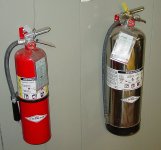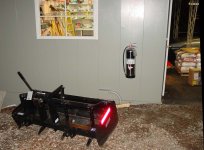As a firefighter and an insurance professional that has provided many hours of fire extinguishers training and who advises clients on a daily bases about fire protection in commercial applications, my comment are as follows:
First off call the fire department, and then fight the fire, if that is what you choose to do. By the time you determine your efforts are not working, it maybe too late. As a firefighter I would rather be called to a fire that is out or nearly out then pulling up and being told a person is trapped because they stayed too long to fight a fire. I investigated a fire a while back where the security staff used 40 fire extinguishers on a fire and THEN decided to call the FD, WRONG!!.
The best fire extinguisher is a garden hose, unlimited supply of agent, can handle wood, paper, etc. The NYC FD has a firefighter assigned to a 2.5 gallon water fire extinguisher on each ladder company. They call him/her “The Can Man”, they put a lot of fire out using this simple fire extinguisher. They have quick knock down of the fire often before an engine company gets on the scene. For grease, combustible metals and electric DO NOT USE WATER.
For a garage of your size I would recommend at least 4 ABC fire extinguishers, minimum 2-A:10-B:C or higher. Why four? National Fire Protection Association, NFPA would call for a minimum of 2 fire extinguishers for your size building. Remember NFPA is the MINIUM. The fire extinguisher I recommended would last about 10-15 seconds, not much time to do a lot of firefighting. REMEMBER you have called the FD and they are on the way. If the fire is not getting smaller with the first fire extinguisher, get out and close doors as you leave. I recommend 4 only so they are close by and not behind something or out of sight. Also make sure you get a new fire extinguishers every few years especially if you buy the cheap ones at the big box stores. Also look at the gauge monthly to make sure it is in the green area. If you have not had fire extinguisher training, read the label on how they work BEFORE the fire. Now that may sound like common sense, but I investigated a fire where the person said the fire extinguisher did not work. I asked the person to show me the extinguisher he used. The pin was still in the handle, the plastic handle was broken from him trying to squeeze the handle. Guess he will not forget to pull the pin the next time. Application of the agent is very important to extinguish the fire. Aim at the base of the fire, sweeping motion left to right, if the fire gets smaller move in on the fire if not get out. REMEMBER always have the exit at your back and not in front of the fire.
Regarding Halon systems currently installed in computer room or any other application and located in the United States, the following applies:
You are under no legal obligation to remove systems from service.
There is no federal legal requirement to remove systems from service by any specific date.
You may legally recharge your system in the event of a discharge
Recycled agent is still commonly available for fire system recharge.
No new agent 1301 is being manufactured.
The most common replacement gas now being used as a replacement for Halon is a gas known as FM 200. See this web site for the info on the gas.
link


